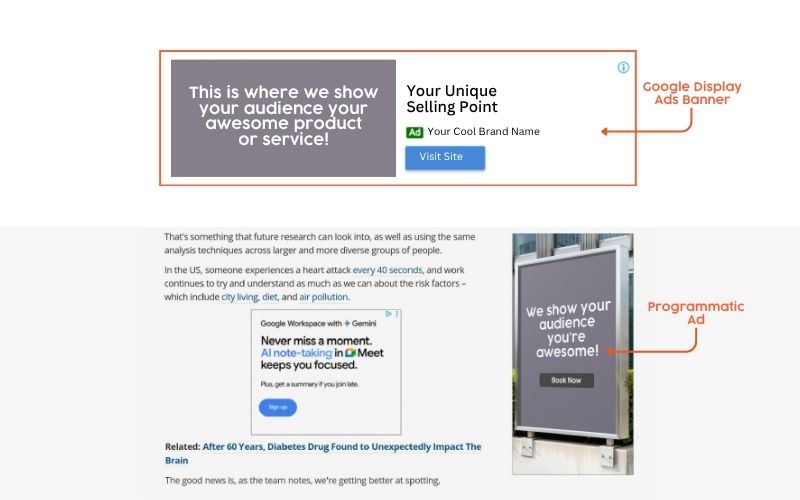If you’ve ever run programmatic ads (or considered them), you’ve probably had this nagging question: Where exactly do these ads show up?
Are they appearing in reputable places? Are they reaching real patients? Or are they buried on obscure sites no one trusts?
Even worse, have they appeared in quite inappropriate places that damage your brand? It’s not an unreasonable fear. Major brands like Kellogg’s, Procter and Gamble, and Coca-Cola have unintentionally run ads beside deeply controversial content.
At Splice, we understand that healthcare is a high-trust space. Your patients deserve credible information, and your brand deserves safe, strategic placement.
So let’s demystify programmatic advertising and show how you can know where your ads are landing.
What is programmatic advertising?
Programmatic advertising is an automated way of buying ad space across a vast network of websites, using data to place your ads where your audience is most likely to engage.
Within programmatic, there are two common ad formats: display ads and native ads.
Display ads are the banners you typically see at the top or sides of a webpage. They’re highly visual, brand-forward, and designed to stand out from the content around them. That visibility makes people aware of your brand. Even if they don’t click the ad, you’ve planted a seed for future recognition and trust.
Native ads, on the other hand, are made to blend in. They appear within article feeds or next to editorial content and are styled to look like part of the page, often featuring a simple image and short headline with a “Sponsored” tag. Someone reading an article about lower back pain, for example, might see a strategically placed ad for a local physiotherapy practice and decide to book, especially if they’ve seen your ad before, thanks to display advertising.
Both types have their place in your healthcare marketing strategy. At Splice, we recommend using them in tandem: display for brand awareness, and native for trust-building and conversion.
Controlling where your ads land (yes, you can)
Programmatic advertising should not be a “spray-and-pray” tactic. Automation can certainly generate a good ROI, but human oversight is required to avoid pitfalls and ensure those ads are placed where they benefit your brand.
When running programmatic ads, Splice Marketing’s experienced team:
- Excludes unsafe or irrelevant sites
- Prioritises healthcare and news-specific domains
- Targets by device, time of day, location, and even behavioural signals
- Whitelists trusted publishers and blocks controversial or off-brand environments.
In short, we help our clients maintain brand integrity while scaling their reach.
Where could your ads show up?
With programmatic ads, the placements are dynamic – but that doesn’t mean random. We use carefully curated targeting and content controls to make sure your ads show up where they matter.
Depending on your brand and your strategy, your ads could appear on sites such as:
- Healthline
- Cleveland Clinic
- Mayo Clinic
- Medical News Today
These aren’t low-tier sites. They’re brand-safe, healthcare-sensitive platforms where your future patients are actively reading, researching and deciding.
Advanced targeting = better ROI
With programmatic advertising, you’re not just buying placements; you’re buying access to patient intent.
Here’s how we do it:
| Geo-targeting | Shows ads only to people within your service radius. |
| Behavioural targeting | Reaches patients researching symptoms, booking health services, or exploring treatment options. |
| Retargeting | Brings back visitors who’ve interacted with your brand but haven’t yet converted. |
| Contextual targeting | Serves ads alongside content about your services (e.g. “pelvic floor therapy” or “migraine treatments”). |
| Third-party audience segments | Accesses pre-determined audience segments from trusted, large data providers, segmented by purchase intent, demographics, and other variables. |
| High-intent keyword targeting | Targets audiences searching with high-intent keywords, making them more likely to act on your ad. |
These strategies dramatically increase the relevance of your ads, leading to higher click-through rates, stronger leads and a better return on ad spend.
So… should your healthcare business be using programmatic ads?
If you’re looking to increase brand awareness, attract new patients, and enjoy sustainable growth, the answer is probably, “Yes.”
But it has to be done right. That means with regulatory compliance, brand safety, and ROI at the core.
At Splice Marketing, we specialise in healthcare-only programmatic advertising. We know the platforms, the placements and the privacy protocols. And we know how to get your ads in front of the right people, in the right context, at the right time.
Ready to see where your ads could go?
If you’re considering programmatic ads – or if you’re already running them and want a second opinion – please book your free 30-minute strategy session.
We’ll show you how Splice keeps your brand safe, compliant and visible in all the right places.







